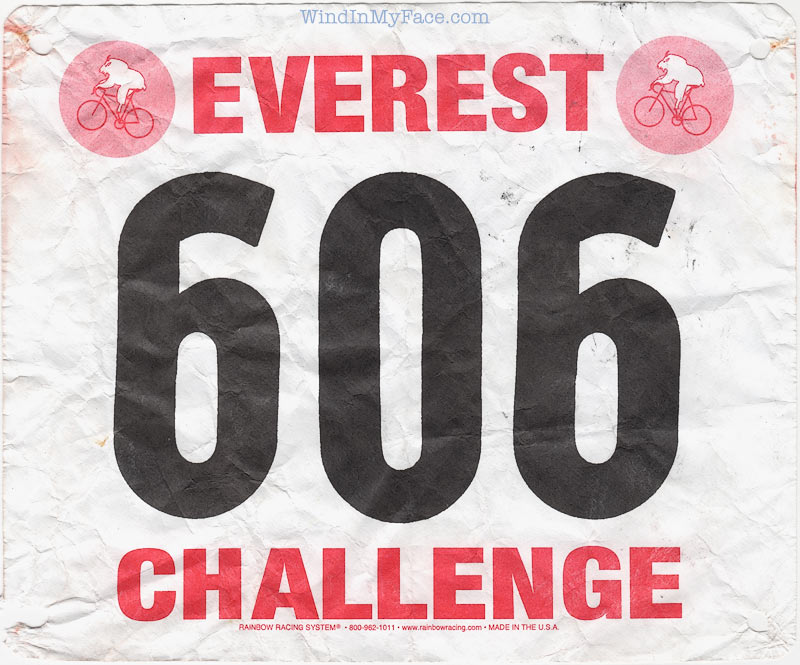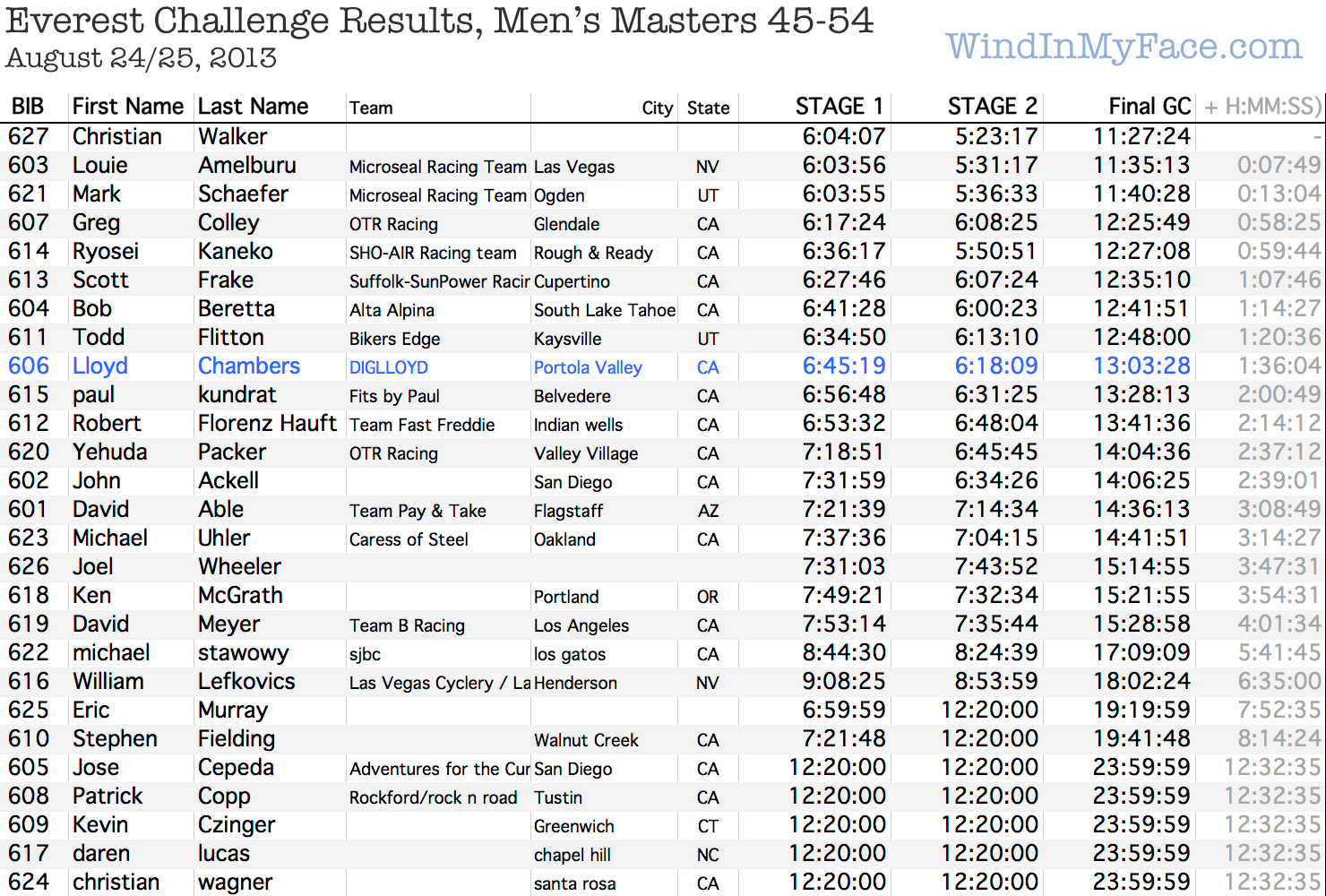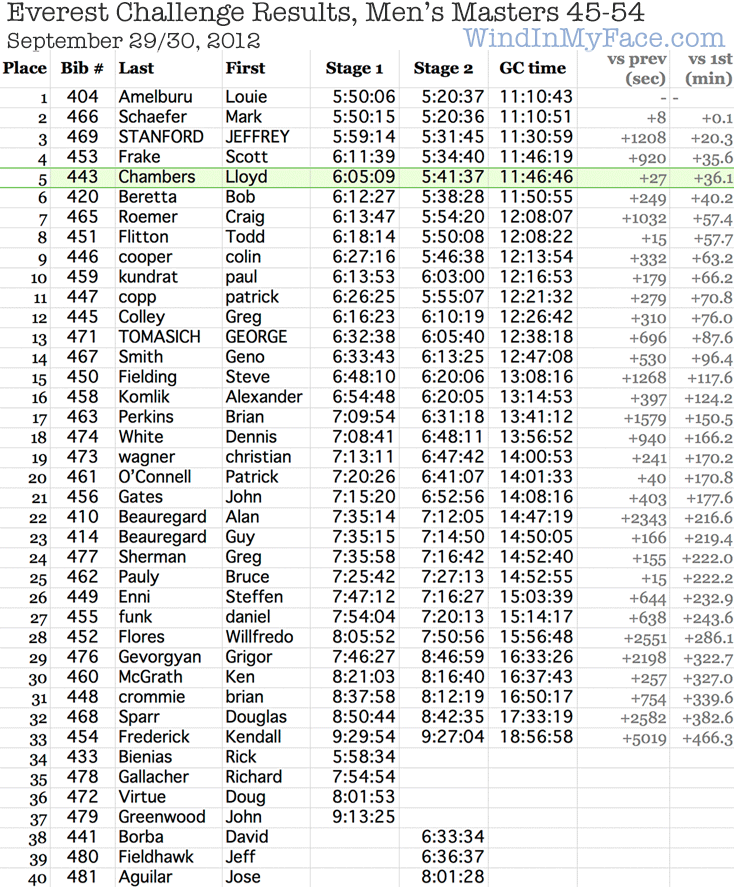Everest Challenge Results

I completed the Everest Challenge under weather conditions that could not have been more favorable for August: unbelievably cool, meaning that temperatures exceeded 90° F only at low elevations and later in the day.
I was 9th in Men's Masters 45-54 for Everest Challenge 2013. results tabulated further below.
Everyone was slower in 2013
Even top finishers were 25-30 minutes slower this year*:
- Louie Amelburu: +24 minutes.
- Mark Schaefer: +27 minutes.
- Scott Frake: +46 minutes.
- Bob Berreta: +49 minutes.
- Lloyd Chambers (me): +75 minutes.
There is no obvious explanation for the slower 2013 times for the fast riders.
In my case my total riding weight (TRW) was 4.4% heavier. Calculating a slower rate of climbing speed for the extra weight suggests a time difference of around 20 minutes, e.g. 12:43 or +55 minutes versus 2012.
That calculation is not that far off the range seen above. Subtracting three minutes for my solo effort across the Day 1 flats yields +52 minutes, which is quite close to the Frake and Berreta time differences.
Figuring for my abbreviated training schedule and small airway impairment (asthma, more on that below), my 2013 effort looks to have been about as good as I might have realistically expected.
My big weakness is the insanely fast descents (Bishop Creek and Glacier Lodge), where one can hit 55 mph at times. I follow a measure of caution while descending, and ~42 miles per hour is about as fast I feel comfortable at on those descents (peak speeds briefly hit 45 mph on Bishop Creek and Glacier Lodge). Which means I always lose 2-3 minutes to the fast descenders. It’s an annoying way to lose time after working so hard climbing, but I don’t like taking on the risk.
* 2 minutes subtracted from 2013 time for slightly longer Rock Creek course based on pre-race riding and markers set.
Day summary
Day 1 went pretty well, with no obvious issues. But lower power and slower ascents than 2012, even adjusting for weight and a 2-3 minute longer course. Unexpected power reduction (watts) as I started the Upper Rock Creek climb (fueling seemed OK, no cramps, probably just plain fitness/fatigue). Still, I gained on or passed many riders, and no one passed me on the climb. Odd on both counts.
Day 2 I woke up with small airway impairment (a low level but audible wheezing), but I was prepping for the start and forgot about it. On the first climb, I noted a rapid heavy breathing no one else had; it seemed peculiar at the time. It wasn’t until the next day that I put those two facts together with my somewhat disappointing Day 2 time: it seems clear that I was suffering from a 10-15% impairment of my small airways (past pulmonary tests make such figures much more than guesswork). Which explains the lower power output, particularly so at higher altitude. Which is consistent with not enough oxygen to feed muscles for higher power output over a long time, though I could manage to do so for shorter bursts.
All week long prior while acclimatizing, I could breathe deeply and freely. But that big fire in Yosemite could be smelled by Saturday (Day 1) and the wind was whipping up clouds of dust, so it seems that my lungs did not take kindly to the particulate matter in the air.
Bottom line is that I was in lesser condition, ~7 pounds heavier, and competing with impaired lung function. Maybe next year I can eliminate all three of those negatives.

Compared to the 2012 Everest Challenge — “what if”?
This 2013 Everest Challenge course was ~2 minutes longer (rough estimate), because the finish was placed all the way at the summit of Mosquito Flat (top of Rock Creek, 1st day).
The “what if” calculation—
In 2012, I was leaner by 7 pounds, and had a far deeper training base and did not suffer from small airway impairment (asthma) and did not have to solo across the flats to Pine Creek, so everything was ideal.
Adjusting my 2012 Everest Challenge time by +2 minutes for the course change to 11:48:46, this would have been good for 4th place in 2013 (see listing above). So the question is whether I can achieve 2012 fitness in 2014 and thus have a shot at the top three finishers.









